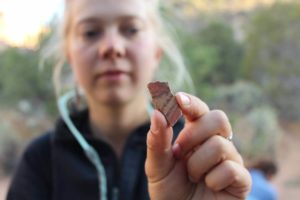
As the first gentle hue of daylight blends with the few stars left over from a chilly night, our fearless leader of the day opens their eyes. They stumble blindly into our outdoor kitchen, bring fresh water from a trickling seep to a boil and wake their sleepy classmates from an undisturbed slumber. Another day of meandering through canyons filled with mostly dry washes, resilient juniper trees, and tiny toads ensues. There is a constant theme racing through the minds and agendas of these travelling students: water. This factor will determine each and every one of our rest stops, routes and campsites in beautiful Dark Canyon.

Lingering in the atmosphere of this very canyon is the life that used to know the ins and outs of every spring, seep and pothole. The people that once occupied this place, that built solid structures from clay and rocks and wove sturdy sandals from the abundant yucca plant, no longer live under the sandstone alcoves of the canyon walls, but their presence remains. As we hike we pass multiple structures tucked neatly against the crumbly rocks, called granaries, once used for storage.
The ancient human history that riddles the walls of these canyons has shaped much of the culture on the Colorado Plateau. Descendants of ancestors that used to live here, tribes such as the Ute Mountain Ute, Navajo Nation, Ute Indian Tribe of the Uintah Ouray, Hopi Nation and Zuni Tribe, have been fighting for over eighty years for this land to be protected due to all of the historical, cultural and scientific knowledge offered here. 1.35 million acres of this land, called Bears Ears, was established as a monument in 2016 by President Obama and then, after the election of Donald Trump, was reduced by 85% just over one year later. This unprotected land causes a great pain in the hearts of each group fighting for its protection, especially the tribes who long to preserve the sacred memory of their people.
Fighters like the Navajo headman K’aay’elii, born in the early 1800s, used these very canyons to escape the U.S Army, avoiding the Long Walk and relocation to Bosque Redondo. It is to these people that we hold a deep gratitude as we study the history of the Colorado Plateau and its revolutionary atmosphere. It is said that ten times the number of people that live in San Juan County today used to inhabit this landscape. Reciprocity and sustainability echoed thematically throughout the land until settlers arrived from distant countries and claimed this land as their own. This destructive sequence of events drove the Indigenous peoples who lived there away from their homes.
Thousands of years later we stand in this canyon, humbly walking through this public land charged with controversy, all the while soaking up vast arrays of knowledge and far too much desert sun. We can only attempt to grasp what it may have been like to adapt to the harsh conditions Dark Canyon provides: hunting for food, scavenging for small pools of water, and scoping out shelter from winds, monsoons, or blistering heat. We shuffle through this wilderness as autumn descends upon the deciduous cottonwoods, with the intention to learn from ancient civilizations and systems of the highly adaptive desert biome. As young environmentalists, it is our hope to shed light on meticulously forgotten histories of Native people as well as the land that they lived in symbiosis with for thousands of years.
The simmering day sizzles out like a Whisper Light stove after dinner is cooked, and we all return to our temporary shelters, smooshed in next to our friends, our family. As the stars return to vision and the crickets commence their consistent melody, our hearts are full of a deep admiration for all that Dark Canyon contributes to our culture and our knowledge-seeking minds.